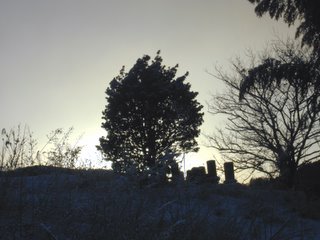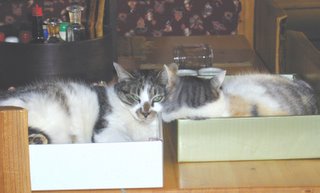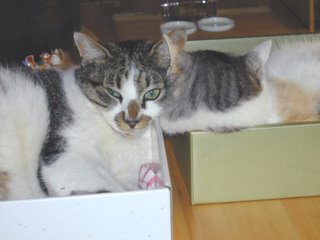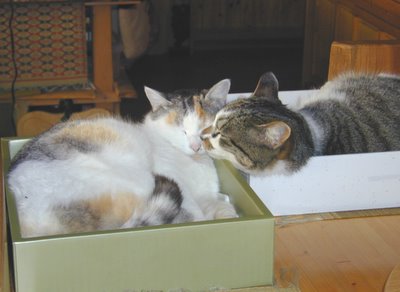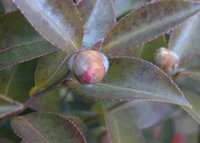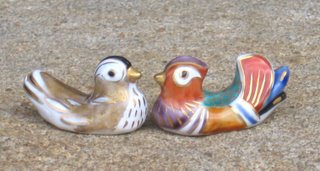[ . BACK to WORLDKIGO . TOP . ]
:::::::::::::::::::::::::::::::::::::::::::::::::::::::::::::::::::::::::::::::::::::::::::::::::::::
. WKD - - - Cultural Keywords of the World - - - .
September 2 -
kutsu no hi 靴の日 day of the shoes
The second (tsu) day of the ninth (ku) month.
This is a pun on the Japanese KU (9) and the English TWO - TSUU - 2 ツー【two】.
 Ku 2 no Hi -
Ku 2 no Hi -
the things we learn
via haiku
. geta, Wooden Sandals, Clogs, 下駄 .
waraji, zoori, zôri 草履 straw sandals
sneakers poems by Don Baird
source : Sneaker-Ku
:::::::::::::::::::::::::::::::::::::::::::::::::::::::::::::::::::::::::::::::::::::::::::::::::::::
a pair of shoes
in a lone forest -
the Japanese soul
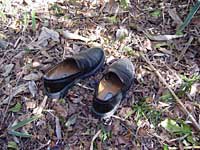
above photo and following article from
The Japan Times: Jan. 17, 2006 (C) All rights reserved
http://www.japantimes.co.jp/cgi-bin/getarticle.pl5?ek20060117wh.htm
:::::::::::::::::::::::::::::::::::::::::::::::::::::::::::::::::::::::::::::::::::::::::::::::::::::
So, what the heck is that?
By ALICE GORDENKER
Dear Alice:
The day after Christmas I went with friends to the top of Jukkoku Pass in Shizuoka Prefecture, which offers fabulous views of Mount Fuji in one direction and the Izu Peninsula in the other. We decided to hike down rather than take the cable car and bus, but shortly after we began our descent we came across a pair of men's dress shoes lined up neatly by the side of the path, toes pointing toward the thick bamboo woods.
For some reason, I was afraid the shoes meant that a suicide had taken place, and I insisted that we take a picture and notify someone. My hunch was confirmed by how seriously the park office took my report. They sent up a search party and called the police, but I don't know what happened after that.
Can you find out?
And can you explain why Japanese take off their shoes before they commit suicide?
Laura B., Yokohama
Dear Laura,
Your photo affected me deeply so I called the park office right away. The man knew exactly what I was talking about. "It's quite a mystery," he said. "We never did find a body, and although we checked the parking lots for abandoned cars and the police checked missing-person reports, nothing has turned up that can be connected with the shoes."
I asked why park officials assumed a suicide when they got your report. "Nantonaku," was all he said, which in this case is probably best translated as "That just seemed to be what it was." When I commented that I had a hard time understanding why someone choose to take off their shoes before they die, especially in the woods in the middle of winter, there was a long pause.
"Do you mean to say" (and I could hear the wonder in his voice) "that in your country suicides don't take off their shoes?"
No, and while we're making comparisons, let me interject that Japan's rate of suicide is the highest among all the G7 countries, and more than twice the rate of that in the United States. In 2004, 32,325 people in Japan took their own lives, more than four times the number who died in traffic accidents. Men are far more likely to commit suicide than women, but in some age groups suicide is the leading cause of death for both sexes. Suicide is a very serious problem in Japan, and one that affects those left behind too.
That's why on Dec. 26 -- the very day you found those shoes -- the government announced a plan to reduce the number of suicides to about 25,000 per year over the next decade, largely by increasing the availability of counseling.
But let's get back to the shoe question. A spokesperson at the National Police Agency confirmed it's common for suicides to remove their shoes, but far from universal. There have been some high-profile shoeless suicides, like film director Juzo Itami, who reportedly left his shoes behind when he jumped to his death in 1997. Do the police keep statistics on this? "No, there's no point. We factor that in when determining whether the death was a suicide [if the shoes were deliberately removed the death is deemed less likely to have been an accident or murder]. Other than that, it's irrelevant."
I asked several people why Japanese might feel the urge to remove their shoes before committing suicide. Some had expertise in the psychology of suicide, some did not. The theories included the following: so as not to carry dirt from this world into the next; to indicate that the death was a suicide; to increase the chances of the body being found; because that's what samurai used to do; and because it's what they've seen on TV (it's a cliche in television dramas to indicate a suicide by showing a pair of shoes on a cliff or the roof of a building).
The most neurotic rationale offered, by quite a few women who have obviously spent too many years lining up shoes in entranceways, was that it's better to remove one's shoes than have them come off during the fall and land in some embarrassingly untidy way.
:::::::::::::::::::::::::::::::::::::::::::::::::::::::::::::::::::::::::::::::::::::::::::::::::::::
Gabi :
Today in the newspaper, Japan Times, was a sentence that made me smile.The author was making enquiries about the habit of Japanese people taking off their shoes before committing suicide. Her Japanese partner re-questioned:
*Do you mean to say* (and I could hear the wonder in his voice)
* that in your country suicides do not take off their shoes? *
Anyway, what seems plain and simple and way beyond needing explanation on one side of the globe, is quite a different matter in a different culture.
Never take anything for granted when it comes to a different culture. Asian cultures have a very different cultural and religious background than Europe/America.
The World Kigo Database is a small step in trying to explain the various cultural meanings of words, festivals and customs from all over the world.
The World Kigo Database
:::::::::::::::::::::::::::::::::::::::::::::::::::::::::::::::::::::::::::::::::::::::::::::::::::::
. Crosscultural Musings
by Gabi Greve
:::::::::::::::::::::::::::::::::::::::::::::::::::::::::::::::::::::::::::::::::::::::::::::::::::::
[ . BACK to DARUMA MUSEUM TOP . ]
[ . BACK to WORLDKIGO . TOP . ]
:::::::::::::::::::::::::::::::::::::::::::::::::::::::::::::::::::::::::::::::::::::::::::::::::::::







